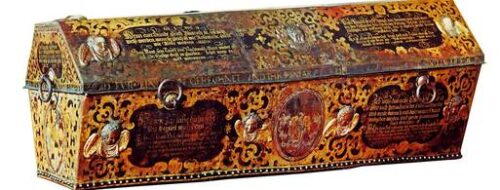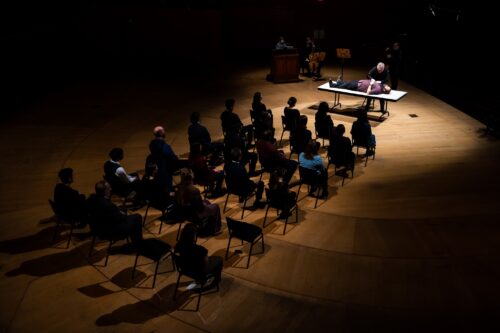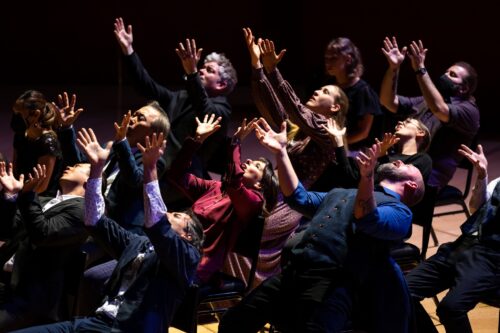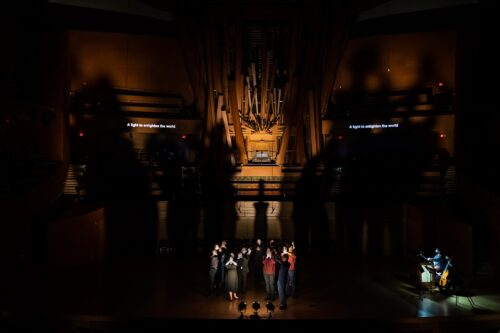HEAVEN AWAITS
“Exequien” in German are funeral observances, and the three pieces of Heinrich Schütz‘s Musikalische Exequien were originally performed in February 1636 for the funeral of Heinrich Posthumus von Reuss, a prince and diplomat who was a personal friend of the composer. Funeral arrangements are likely to weigh heavily on your mind if you’re gone through your life with the name ’˜Posthumus’ von Reuss came by his name on account of being born after the death of his father, and his arrangements for his own funeral were precise to the letter, with every text and reading prescribed. Reuss commissioned the music from Schütz, providing him with German texts roughly analogous to the Latin requiem mass (the work was the first requiem in the German language). von Reuss went so far as to design his own copper sarcophagus inscribed with the text, which has been restored and put on public display in the Thüringen city of Gura.
 Following the success of Lagrime di San Pietro, which had movement accompanying singing, the L.A. Master Chorale took on Schütz’s gorgeous piece of music, and then had director Peter Sellars capture its emotional intensity by staging the 24 singers in various stages of grieving, loss, and comfort. As if at a homegrown memorial service, the ensemble was seated on simple chairs in six rows of four facing downstage left toward a non-specific table which served as a bier, a deathbed, etc. With music memorized, the group — wearing street clothes from black to dark pastel (Danielle Domingue Sumi, costumes) — would morph for each of the continuously variable passages, from ensemble to soloists. The latter was particularly effective when a chorale member would lie on the table while a mournful family member or friend would hold their hand as they departed.
Following the success of Lagrime di San Pietro, which had movement accompanying singing, the L.A. Master Chorale took on Schütz’s gorgeous piece of music, and then had director Peter Sellars capture its emotional intensity by staging the 24 singers in various stages of grieving, loss, and comfort. As if at a homegrown memorial service, the ensemble was seated on simple chairs in six rows of four facing downstage left toward a non-specific table which served as a bier, a deathbed, etc. With music memorized, the group — wearing street clothes from black to dark pastel (Danielle Domingue Sumi, costumes) — would morph for each of the continuously variable passages, from ensemble to soloists. The latter was particularly effective when a chorale member would lie on the table while a mournful family member or friend would hold their hand as they departed.
You might think of this as the authentic performance among authentic performances. The continuo here is a small portative organ (played very softly like a flute by Lisa Edwards) and a viol de gamba (exquisitely played by Eva Lymenstull), an arrangement apparently suggested by Schütz himself. The singers were continually warm, avoiding sharp singing even in the periodic harmonic clashes. Director Grant Gershon glided in and out of the scenes surreptitiously, so that his conducting was always in view.
The idea here is that we have so much to grieve — from mass shootings, war, and COVID — that this staging would assist audiences in letting go. (No doubt this piece will travel just as Lagrime di San Pietro has.) Even if it wasn’t staged the singers mastered all of the polyphony and double choir textures, as well as the enunciation of the texts, which are a selection of scriptural readings and hymns with little obvious sense of musical or semantic coherence. Schütz’s solution to his benefactor’s texts is essentially episodic, with homophonic chorales interspersing recitative-like solo and small ensemble passages, all sung at a near pianissimo level (the acoustics at Disney Hall took care of the rest). James F. Ingalls‘ lights also changed, from a tight spot on the “bed” to a front light that projected shadows on the giant “French Fry” organ behind the players.
The result was a spiritual, meditative, and sometimes sad experience. For the first half of about 65 minutes, I sensed that this was a once-in-a-lifetime event. It’s so ideal for our times, and the chorale showed off some astounding skills at emoting while singing with plaintive simplicity. Clarity and precise balance were everywhere in evidence, and solo voices had character and warmth. But something strange began to happen up until the end. I drifted. Not that the piece had a soporific effect, but it did feel like I was under the spell of some kind of narcotic, as if being drawn to The Light. What a fascinating experience to have during the final beautifully lit scene, which had the chorus members gathered around a grave to bury someone they held dear. I read that the deceased is represented by bass voices, while angels accompanying it to heaven are represented by the sopranos. Well done. I certainly ended up in heaven.
photos by Brian Feinzimer
Los Angeles Master Chorale
Musikalische Exequien (Music to Accompany a Departure)
played November 20, 2022 at Disney Hall
for more info, visit LAMC
![Post image for Music Review: MUSIKALISCHE EXEQUIEN [MUSIC TO ACCOMPANY A DEPARTURE] (L.A. Master Chorale)](https://stageandcinema.com/wp-content/uploads/2022/11/music-to-accompany-departure-poster-lamc.jpg)



